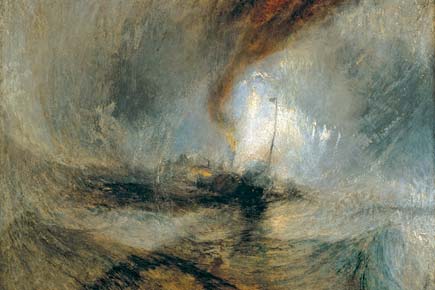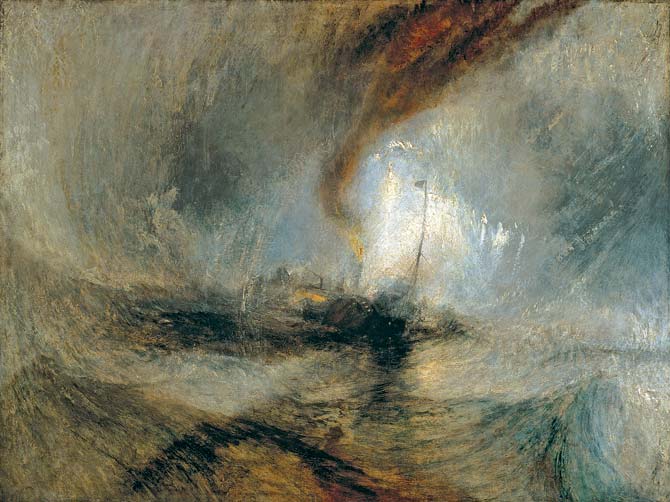On January 24, those who love the drama of the high seas or the animated paintings of Joseph Mallord William Turner will be in for a rare treat


JMW Turner brought the Romantic spirit into his marine paintings. Seen above is Turner’s Snow Storm: Steam-Boat off a Harbour’s Mouth, first exhibited in 1842
On January 24, those who love the drama of the high seas or the animated paintings of Joseph Mallord William Turner will be in for a rare treat.
ADVERTISEMENT
David Blayney Brown, the Manton curator of British Art (1790–1850), who looks into the Turner collection at Tate Britain, London, will deliver a lecture Chhatrapati Shivaji Maharaj Vastu Sangrahalaya, in a lecture titled JMW Turner: A Marine Master in a Modernising World. The lecture series is part of an annual tradition – now in its 19th year – hosted by the Vasant J Sheth Memorial Foundation, a maritime institution, in honour of the eponymous late founder of a private shipping company.

David Blayney Brown. Pic/Poonam Bathija
Brown has curated and co-curated many exhibitions, most recently Late Turner: Painting Set Free (shown in London, Los Angeles, San Francisco and Toronto). He convened Tate's research centre for British Romantic Art and is currently preparing for an exhibition of Turner and the Modern World. Ahead of the lecture, we meet him in Colaba on Saturday. Edited excerpts from the interview:
According to you, what is the story of English maritime history that is portrayed collectively by Turner's works?
Turner shows English maritime history at a particular period, at a time when things were changing enormously. This was the time for Napoleonic Wars; Britain had to defend its coast against France and Spain, so its shipping affairs around the world were at risk. And, Turner's generation knew that you couldn't travel anywhere unless it was by sea, and the sea was a dangerous place.
After The Battle of Trafalgar [in 1805, between the British Royal Navy against the combined fleets of the French and Spanish navies and the subject of a reputed work by Turner], he shows a different kind of life at sea. There is trade, travel and tourism, the return of the sailing warships that fought during the Napoleonic Wars, and steam ships. That shows how closely tuned in he was with his time. He had the unique gift of portraying his own times.
Turner was practising around the same time as the artists who belonged to the tradition of British Maritime Art. What do you think set Turner apart?
For marine artists, a few of whom were former sailors, the subject was more important than the work of art. Marine portraits were often ship portraits and a simple representation of a particular event. In Turner’s time, marine art was seen as a type of landscape art; you couldn’t paint ships without painting the sea, the sky, the waves and the wind. However, unlike many marine artists, Turner was able to bring together stories, ships and the elements – he brings the Romantic spirit into marine painting. Turner made the sea into the narrative and pared down marine painting to its essentials. He could make the sea look real.
If you take the painting, Snow Storm: Steam-Boat off a Harbour's Mouth, the first word he uses in the title is about the weather, the elements. There is this clash between the ship and the sea. The thing about a steamship was that it harnesses the power of the elements — how you get steam, from fire and water. That painting is about energies — natural and manmade. The two are fighting it out — who is going to win? For Turner, it was as much about the storm as the ship, as well as about inventions and progress, whereas marine painting was just about the latter.
As you mention inventions, Turner's time was when Britain was entering the Industrial Revolution. Was he opposed to the many changes that he saw around him?
That kind of notion has been put upon him by his 19th century admirers, who were against industrial progress and wanted to co-opt him into this hostility. But, I don’t think Turner was hostile at all. In fact, he wanted to document and celebrate new inventions. He did not see them as 'horrid ugly smoky ships that should be banned' but, saw them as the future.
It is a coincidence that you will be speaking about Turner at a prominent port city that was once an important centre of the British Empire. Turner's works have captured elements of empire building, deportation of slaves and British trade. Was Turner critical of the Empire?
I think he was critical not of the idea of empire itself – nobody was at that time – but of certain aspects. He was definitely anti-slavery [as seen in Slavers Throwing overboard the Dead and Dying—Typhon coming on]. He was also critical of sending convicts out to Australia.
 Subscribe today by clicking the link and stay updated with the latest news!" Click here!
Subscribe today by clicking the link and stay updated with the latest news!" Click here!







